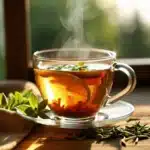Rose milk tea is more than just a pretty drink—it’s a moment of calm, a memory in a cup, and a delicate blend of tradition and creativity. I’m Mary, known around Bath as “The Pudding Lady,” and while my love for puddings is lifelong, rose milk tea has quietly become one of my most cherished comforts.
My journey with rose milk tea began in my mother’s kitchen, where rose petals dried on linen and the scent of milk warming on the stove wrapped around us like a blanket. I was the girl with flour in her hair, always sneaking spoonfuls of sugar, and believing that any recipe touched with flowers must have some magic in it.
Though I never trained as a chef, I baked everything—treacle puddings, jam-topped sponges, and custards that nearly worked. Over time, I started sharing my creations at village fairs and charity teas. Eventually, someone asked, “Why don’t you teach this?” And so, my weekend pudding club was born—just six guests at a time, warm mugs in hand, stories shared, and always, rose milk tea steeped to perfection.

In this article, I’ll share everything you need to know about rose milk tea—how to make it from scratch, what it tastes like, whether it has caffeine, and how it’s different from classic rose tea with milk. Whether you’re here out of curiosity or already a fan of floral flavors, this guide will steep you deep into the soothing world of rose milk tea.
Table of Contents
What Is Rose Milk Tea?
Rose milk tea is a fusion beverage made by combining rose essence (usually in the form of rose syrup, petals, or extract) with milk, and optionally, a tea base like black, green, or oolong tea. Some versions even skip the tea entirely for a caffeine-free delight. What gives this drink its signature charm is its soft pink hue and delicate floral fragrance.
With the rise of Instagram-worthy drinks and an increasing interest in herbal wellness, rose milk tea has grown popular worldwide. It’s now a regular on café menus, especially in bubble tea shops and specialty tea houses.
From its delicate aroma to its aesthetic appeal, rose milk tea is beloved by both tea enthusiasts and casual drinkers. Whether it’s part of your self-care routine or a fun alternative to coffee, its comforting presence makes it a favorite for many.
Origins and Cultural Influence of Rose Milk Beverages
The concept of mixing milk with rose has ancient roots in Persian, Indian, and Middle Eastern cultures, where rose water and rose petals have long been used in cooking and drinks. In Ayurveda and Unani medicine, rose has been used for its cooling, anti-inflammatory, and mood-enhancing properties.
In modern times, this traditional combination has been reinvented in cafés across Asia and the West, particularly in Taiwanese bubble tea culture. The addition of tapioca pearls or jelly makes it both a drink and a dessert.
From ancient apothecaries to trendy tea bars, rose milk tea has traveled far—and continues to evolve with each sip.
Key Ingredients in Rose Milk Tea

What Makes the Perfect Rose Flavor: Petals, Syrup, or Extract
To create the perfect rose milk tea, the star ingredient is, of course, the rose itself. But not all rose flavorings are equal, and the type you choose can significantly affect taste, aroma, and even color.
Here are the three main ways to infuse rose into your tea:
| Ingredient Type | Description | Best Use |
|---|---|---|
| Dried Rose Petals | Light and fragrant, they steep like herbal tea | Best for herbal infusions or natural tea |
| Rose Syrup | Sweetened, strong rose flavor with a pink tint | Ideal for cold drinks and bubble teas |
| Rose Extract or Rose Water | Concentrated essence, very aromatic | Use sparingly for aroma without overpowering taste |
For those seeking a more natural and calming floral experience, dried petals are ideal. Want a sweet, pink boba-shop-style tea? Go for rose syrup. And if you’re just after fragrance? A drop or two of rose extract is all you need.
It’s worth noting that organic or food-grade rose products are a must. Never use roses from florists, as they may be treated with pesticides.
Types of Milk Used: Dairy, Almond, Oat, and Other Plant-Based Options
Milk is the base that balances the floral intensity and adds creaminess. Depending on your dietary preference or desired texture, there are several options to consider for your rose milk tea recipe:
- Whole Milk: Rich, creamy, and traditional
- Almond Milk: Light, nutty, and complements rose flavor beautifully
- Oat Milk: Thick and velvety; perfect for iced or frothy versions
- Coconut Milk: For a tropical floral twist
- Soy Milk: Neutral flavor, a classic dairy-free choice
For a vegan rose milk tea, oat and almond milk are highly recommended because they don’t overpower the rose and blend well with syrups and extracts. Plant-based versions are also easier to digest and often preferred by those with lactose intolerance.
Check out this raspberry-filled vanilla cake to pair with your homemade floral tea!
By carefully choosing both your rose flavoring and milk base, you can tailor your drink for maximum indulgence—whether you want something light and refreshing or rich and dessert-like.
How to Make Rose Milk Tea at Home
Step-by-Step Guide to Homemade Rose Milk Tea
Making rose milk tea at home is easier than it looks—and far more customizable. Whether you’re in the mood for a warm floral latte or a chilled iced tea, this DIY recipe hits all the right notes. Below is a basic rose milk tea recipe that can be adapted to taste, dietary needs, and presentation preferences.
Ingredients
- 1 cup milk (dairy or plant-based like oat or almond)
- 1 black tea bag (or green tea for a lighter taste)
- 1 tablespoon dried rose petals or 1.5 tablespoons rose syrup
- 1–2 teaspoons honey or sugar (optional)
- 1 cup water
- Ice (for iced version)
- Tapioca pearls (optional for bubble tea style)
Instructions
- Boil the Water
In a small saucepan, bring 1 cup of water to a boil. - Add Tea Bag & Rose Petals
Remove from heat. Add the tea bag and rose petals. Cover and let steep for 5–7 minutes. If you’re opting for rose syrup, hold off on adding the petals at this stage. - Strain & Sweeten
Take out the tea bag and strain the mixture to remove the petals. Stir in honey, sugar, or a splash of rose syrup depending on your taste preference. - Add Milk
Pour in warm milk for a hot version, or chilled milk if making iced tea. - Serve Your Way
- Hot Rose Milk Tea: Pour into a mug and serve with a sprinkle of dried petals on top.
- Iced Rose Milk Tea: Fill a glass with ice and pour your tea over it.
- Bubble Tea Style: Add cooked tapioca pearls at the bottom of your cup before pouring the tea.
You can also blend the cold version for a creamy rose milk frappe. It’s visually stunning and extra satisfying!
Learn more about this mousse cake to pair with your afternoon rose milk tea.
Easy Cold Brew vs. Hot Infusion Techniques
There are two common ways to prepare rose milk tea, and each offers a slightly different experience in terms of taste and texture.
| Method | Best For | Instructions |
|---|---|---|
| Hot Infusion | Cozy drinks, stronger rose aroma | Steep rose and tea in hot water, add milk and sweetener |
| Cold Brew | Lighter, refreshing version | Steep tea and petals in cold water for 8 hours, then strain and mix with cold milk and syrup |
The cold brew method is ideal during summer, as it delivers a less bitter, smoother tea base. On the other hand, hot infusion brings out a fuller, bolder flavor—perfect for sipping in the evening with a cozy blanket.
Don’t miss our romantic chocolate strawberry cupcakes that pair divinely with rose-infused drinks.
Health Benefits of Rose Milk Tea
Antioxidant, Relaxation, and Skin Glow Properties
While it’s known for its elegance and photogenic charm, rose milk tea also comes packed with health perks. Whether you sip it warm before bed or enjoy it chilled in the afternoon, this fragrant tea can offer more than just flavor.
Here’s what makes it a surprisingly wholesome choice:
- Rich in Antioxidants
Rose petals contain polyphenols, plant-based antioxidants that help combat oxidative stress, reduce inflammation, and protect cells from damage. - Natural Stress Reliever
Rose has been used in aromatherapy for centuries for its mood-lifting and anxiety-reducing effects. Drinking rose-infused tea can promote a sense of calm and relaxation, making it ideal for unwinding after a long day. - Supports Skin Health
Thanks to its anti-inflammatory and antibacterial properties, rose is believed to improve skin clarity, reduce acne-related inflammation, and support a natural glow from within—especially when combined with hydration from milk and herbal tea. - Aids Digestion
The gentle compounds in rose help soothe the digestive tract and reduce bloating. Many cultures use rose water or rose tea after heavy meals for this very reason. - Menstrual Relief & Hormonal Balance
Some herbalists suggest rose tea helps ease PMS symptoms by calming cramps and balancing mood swings, especially when consumed regularly during the cycle.
Looking for inspiration? Pair this Apple Jacks cereal treat with your calming floral tea for a delightful crunch that complements every sip.
Nutritional Profile of Rose Milk Tea
Here’s a basic breakdown of the nutrients you can expect from a single 8-ounce serving, depending on ingredients:
| Nutrient | Approximate Value (with almond milk & rose syrup) |
|---|---|
| Calories | 60–100 kcal |
| Protein | 1–2 grams |
| Sugar | 5–10 grams |
| Fat | 1–3 grams |
| Antioxidants | Moderate to High (from rose and tea) |
| Caffeine | 0–35mg (depending on tea base) |
Using plant-based milk can significantly reduce calories and saturated fat content. Going for unsweetened rose syrup or natural petals is a great way to make your rose milk tea even healthier.
Don’t miss our salted chocolate cake if you’re feeling indulgent—it’s a bold match to the delicate floral tones of this tea.

Taste Profile – What Does Rose Milk Tea Taste Like?
Flavor Notes: Floral, Creamy, Lightly Sweet
The flavor of rose milk tea can be described in three words: floral, creamy, and smooth. But let’s break it down a little further to capture the full experience:
- Floral Essence: The rose provides a gentle, almost perfume-like fragrance that’s soothing without being overpowering. It tastes like how fresh roses smell—lightly sweet with herbal undertones.
- Creamy Body: Thanks to the milk, the tea has a silky texture. Whether you’re using dairy or oat milk, the creaminess balances the delicate floral notes perfectly.
- Touch of Sweetness: Most rose milk teas include a little sweetener—either honey, sugar, or rose syrup—which brings out the natural fragrance of the rose and enhances the milk’s richness.
The final flavor depends on whether you use black tea (richer and bolder), green tea (lighter and grassier), or none at all (herbal version). Some people describe the taste as a floral latte, while others say it reminds them of Turkish delight or a subtle rosewater dessert.
The temperature also plays a role:
- Iced rose milk tea tends to be refreshing, with a stronger sweetness and lighter floral vibe.
- Hot rose milk tea brings out deeper rose notes and is more comforting.
Discover great ideas like this raspberry-filled vanilla cake that harmonizes with the light floral notes in your rose tea.
Pairing Suggestions: Best Foods to Enjoy with Rose Milk Tea
Thanks to its delicate floral notes and smooth, creamy base, rose milk tea makes an ideal companion for a wide range of snacks and sweet treats. Here are a few pairing recommendations to elevate your tea experience:
| Pairing Type | Example Foods |
|---|---|
| Fruity Desserts | Raspberry cake, lemon tart, peach scones |
| Nutty Snacks | Almond cookies, pistachio baklava |
| Mild Cheeses | Brie with crackers, cream cheese pastries |
| Sweet Bites | Rose macarons, honey biscuits, white chocolate truffles |
For an indulgent weekend treat, pair iced rose milk tea with mini chocolate cakes or light tiramisu to complement its delicate profile without overpowering it.
Check out these mini chocolate cakes to create the ultimate afternoon tea set at home.
Caffeine in Rose Milk Tea – What You Need to Know
Does Rose Milk Tea Contain Caffeine?
The short answer? It depends on how it’s made.
Rose milk tea can be either caffeinated or caffeine-free, depending on the type of tea base you use. Here’s how it breaks down:
| Tea Base | Caffeine Content | Notes |
|---|---|---|
| Black Tea | 30–50 mg per cup | Strong and bold, common in bubble teas |
| Green Tea | 15–30 mg per cup | Lighter taste and caffeine level |
| Oolong Tea | 25–45 mg per cup | Smooth and floral, pairs well with rose |
| No Tea (Herbal Only) | 0 mg | Caffeine-free option using rose petals only |
So if your rose milk tea recipe includes black, green, or oolong tea, you’re getting some caffeine. But if you use just rose petals or rose water with milk, then it’s completely caffeine-free—perfect for evening sipping or caffeine-sensitive folks.
Many people enjoy both versions: a black tea-based rose milk tea for a mid-day pick-me-up and a herbal, milk-only rose drink before bed.
Caffeine-Free Alternatives for Sensitive Drinkers
If you love the floral taste but need to avoid caffeine, you can easily make a decaf rose milk tea or go entirely herbal with rose petals.
Here are a few ways to enjoy it without the buzz:
- Use dried rose petals only: teep 1 tablespoon of organic dried petals in hot water for 5–7 minutes, strain out the petals, then blend the infused liquid with your preferred milk and sweetener.
- Decaffeinated black or green tea: You can find decaf tea bags in most grocery stores—still flavorful, but caffeine-free.
- Chamomile + Rose Blend: For a deeply calming experience, combine dried rose petals with soothing chamomile blossoms. It’s floral, earthy, and sleep-friendly.
- Rooibos Base: This naturally caffeine-free South African red tea is slightly sweet and works beautifully with rose and milk.
With these alternatives, you can sip rose milk tea morning, noon, or night—without worrying about the caffeine crash.
Variations and Customizations

How to Make Rose Tea with Milk (Herbal Version)
Looking for a soothing, caffeine-free version of rose milk tea? This herbal alternative skips the traditional tea base and focuses solely on the calming floral essence of rose petals. It’s easy on the digestive system and perfect for evenings or anyone sensitive to caffeine and other stimulants.
Ingredients for Herbal Rose Tea with Milk:
- 1 tablespoon dried edible rose petals
- 1 cup hot water
- ½ to 1 cup milk (your choice of dairy or plant-based)
- 1 teaspoon honey or maple syrup (optional)
- A pinch of cardamom (optional, for warmth and aroma)
Instructions:
- Steep the Petals: Place dried rose petals in a cup and pour in the hot water. Cover and let steep for 7–10 minutes.
- Strain and Sweeten: Strain the petals and stir in sweetener if desired.
- Add Milk: Gently pour warm or steamed milk into the rose tea infusion, blending for a smooth, comforting drink. Mix gently.
- Serve: Enjoy hot or chill with ice for a refreshing floral drink.
This recipe allows you to fully experience the natural rose flavor without interference from other tea leaves. It’s perfect for meditation time, skincare rituals, or a cozy evening at home.
Bubble Tea Style: Adding Tapioca Pearls and Jellies
Want to give your rose milk tea a fun, chewy twist? Turn it into a rose bubble tea with just a few additions!
Tapioca Pearl Version
Here’s how to make a rose milk boba-style tea like you’d find in cafés:
- Cook Tapioca Pearls: Boil pearls per package directions until chewy and translucent.
- Sweeten the Pearls: Let them sit in sugar syrup or honey for 10 minutes to soak up flavor.
- Layer It: Add pearls to the bottom of your glass, pour in your rose milk tea (iced version works best), and serve with a wide straw.
Alternative Toppings:
- Rose jelly: Made with rose water and agar-agar. Light, floral, and totally vegan.
- Aloe vera cubes: Refreshing and hydrating.
- Basil or chia seeds: For a nutritious, texture-rich addition.
Bubble tea lovers can enjoy all the fun of their favorite beverage while still sipping something unique, elegant, and slightly romantic.
Don’t miss our chocolate-strawberry cupcakes to add something indulgent alongside your next floral bubble tea.
Where to Buy Rose Milk Tea or Ingredients
Best Online Stores and Tea Brands to Try
Not everyone has time to brew tea from scratch. Luckily, there are plenty of online retailers and brands offering high-quality rose milk tea ingredients or ready-made drinks you can enjoy with minimal effort.
Top Online Stores for Ingredients:
| Website | What They Offer |
|---|---|
| Amazon | Rose syrup, dried rose petals, rose water, bubble tea kits |
| iHerb | Organic rose petals, plant-based milk, herbal blends |
| Teavana (Starbucks) | Pre-packaged floral tea blends |
| Etsy | Handmade rose milk tea kits and small-batch rose syrups |
| The Tea Spot | Loose-leaf herbal teas including rose and lavender blends |
Look for culinary-grade or food-safe rose ingredients only. Avoid products labeled as “decorative” or “cosmetic use” if you’re planning to consume them.
Want to make it super easy? Search for:
- “Rose milk tea kit”
- “Organic rose petals for tea”
- “Rose syrup for drinks”
Many of these come bundled with tea bags, dried petals, and even tapioca pearls for a complete experience.
Local Cafes and Chains Offering Rose Milk Tea
If DIY isn’t your style, you’re in luck. More cafes and beverage chains are adding rose milk tea to their menus as demand grows for floral drinks. Here’s where to look:
Popular Chains That Offer Rose Milk Tea (Seasonally or Regularly):
- Gong Cha – Often features rose bubble tea specials
- Chatime – Rose milk tea is part of their rotating menu
- CoCo Fresh Tea & Juice – Renowned for its seasonal floral beverages and creative tea blends
- Boba Guys – Offers real ingredient-based rose milk teas
- Local Cafés – Check artisanal coffee shops or boutique tea bars
When ordering out, ask if the rose flavor comes from syrup, petals, or extract. This lets you gauge whether the taste will be natural, sweetened, or subtle.
Learn more about this heavenly mousse cake that pairs divinely with a chilled rose milk tea on a sunny afternoon.
Expert Tips, Mistakes to Avoid & Serving Ideas
Common Mistakes in Brewing or Mixing Rose Milk Tea
Even though rose milk tea is simple to make, a few small missteps can throw off its delicate flavor. Here’s how to avoid the most common blunders:
| Mistake | Why It’s a Problem | How to Fix It |
|---|---|---|
| Using too much rose | Can taste perfumey or soapy | Start with a small amount (1 tsp dried petals or ½ tbsp syrup) and adjust |
| Oversteeping tea | Causes bitterness, especially with black tea | Steep 3–5 minutes max |
| Skipping sweetener | Makes the tea taste flat | Even a small touch of honey balances the rose |
| Wrong milk choice | Some milks overpower the rose | Use neutral or slightly sweet plant-based milks like oat or almond |
| Using non-edible roses | Can contain chemicals or be unsafe | Only use food-grade dried rose petals or culinary rose water |
Keep in mind, rose milk tea is all about harmony—delicate floral aromas, smooth creamy texture, and just the right touch of sweetness. Too much of anything, and you lose the elegance.
Creative Serving Ideas and Presentation Tips
Presentation plays a huge role in the rose milk tea experience, especially when serving guests or posting to social media. Here are a few serving tips to elevate your drink:
✦ Glassware Matters
- Use a tall clear glass for iced versions to show off the blush-pink color.
- For warm versions, a ceramic floral teacup adds a cozy, vintage vibe.
✦ Garnish with Intention
- Float a few dried rose petals on top for elegance.
- Add a sprinkle of edible glitter or crushed pistachios for an Insta-worthy twist.
- Use a rose-shaped ice cube mold for cold brews.
✦ Pair It Right
- Serve with delicate treats like rose macarons, butter cookies, or mini cheesecakes.
- Consider pairing with a light brunch or tea sandwich spread.
Serving rose milk tea is more than just preparing a drink—it’s a mini moment of beauty and calm.
Discover great ideas like these chocolate raspberry cakes for your next tea party setup.
Conclusion
Whether you’re seeking a peaceful tea moment or an Instagram-worthy beverage that delights the senses, rose milk tea offers the best of both worlds. From its elegant taste and calming aroma to its easy customizations and surprising health benefits, this floral drink has earned its place in the modern tea world.
Try it hot or iced, caffeinated or caffeine-free, plain or as boba. However you enjoy it, one thing’s certain: rose milk tea isn’t just a drink—it’s a vibe.
Don’t miss our romantic dessert ideas to pair with your next tea session.
Fore more recipes follow me in Facebook, medium and Pinterest
FAQs
How to make rose milk tea?
To make rose milk tea, steep 1 black tea bag and 1 tablespoon of dried rose petals in 1 cup of hot water for 5–7 minutes. Strain, then add 1 cup of warm or chilled milk and 1–2 teaspoons of rose syrup or sweetener. Serve hot or iced. Optionally, add tapioca pearls for a bubble tea twist.
What does rose milk tea taste like?
Rose milk tea tastes floral and subtly sweet, with a silky creaminess from the milk. The rose offers a light, fragrant flavor that’s calming and slightly aromatic, while the tea base (if used) adds depth.
Does rose milk tea have caffeine?
It can, depending on the base. When made with black or green tea, rose milk tea contains caffeine (15–50 mg per cup). But if made with just rose petals and milk, it’s completely caffeine-free.
How to make rose tea with milk?
Use 1 tablespoon of dried edible rose petals, steeped in hot water for 7–10 minutes. Strain and add ½ to 1 cup of warm milk. Sweeten if desired. This creates a smooth, caffeine-free herbal rose tea with a creamy finish.
Is rose milk tea good?
Yes, it’s not just delicious—it’s also calming, skin-friendly, and filled with antioxidants. Many enjoy it as a relaxing beverage, especially in the evening or as part of a self-care routine.




